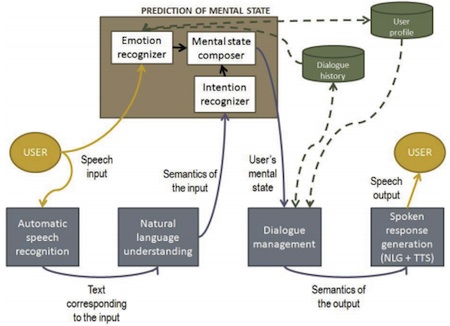Computer Knows You're Mad, Chills You Out
Source: Pohl
 (Integration of mental-state prediction into the architecture of a spoken dialogue system
(Integration of mental-state prediction into the architecture of a spoken dialogue system
From Predicting user mental states in spoken dialogue systems [pdf])
Researchers have created a mental-state prediction method which takes into account both the users' intentions and their emotions; they have also described how to incorporate this recognized mental-state into the architecture of a spoken dialogue system. The resulting system can adapt itself to the emotions of the user in a spoken dialogue, thereby calming the user and increasing the chances of a successful interaction.
As can be seen [in the figure below] the model is placed between the natural language understanding (NLU) and the dialogue management phases. The model is comprised of an emotion recognizer, an intention recognizer and a mental-state composer.
The first step for emotion recognition is feature extraction. The aim is to compute features from the speech input which can be relevant for the detection of emotion in the user’s voice... The features are selected by majority voting of a forward selection algorithm, a genetic search and a ranking filter...
The second step of the emotion recognition process is feature normalization, with which the features extracted in the previous phase are normalized around the user neutral speaking style.
Science fiction fans remember another emotion-sensing artificial intelligence computer - the HAL-9000 computer from the movie 2001: A Space Odyssey.
"I can tell from your voice harmonics, Dave, that you're badly upset. Why don't you take a stress pill and get some rest?"
It's likely that this system would be implemented in cellphone networks. In that context, I'd like to point out that Frederik Pohl's Joymaker from his 1965 novel The Age of the Pussyfoot also sensed excessive emotionality on the part of users - and issued a tranquilizing spray when necessary:
"Cut that out!" Forrester was breathing hard. Abruptly, the joymaker in his hand hissed and sprayed him with something that felt damp for a second, then dissipated.
Forrester felt himself relaxing. He appreciated the tranquilizing spray, without quite liking the idea of a having a machine prescribe and spray it.
| }
|